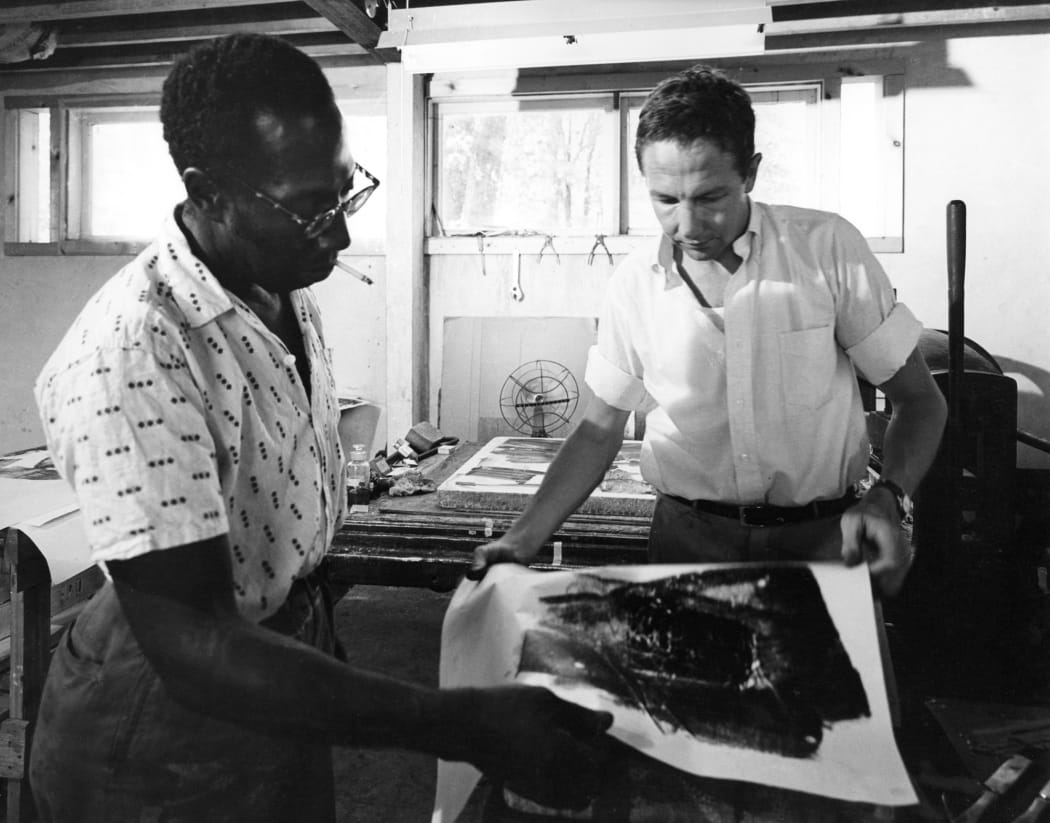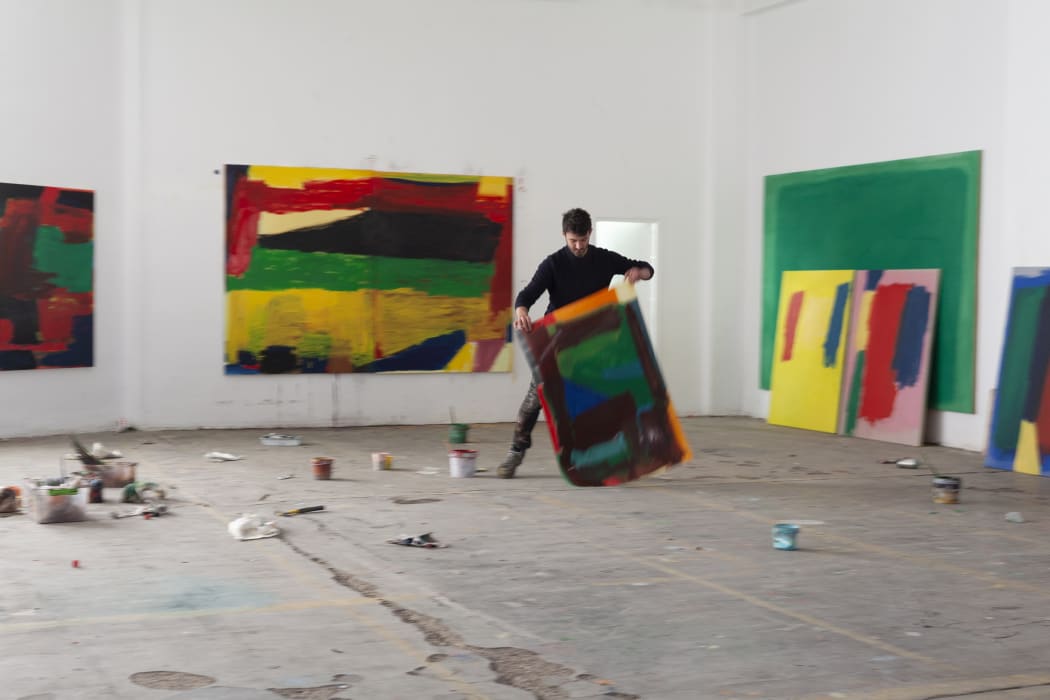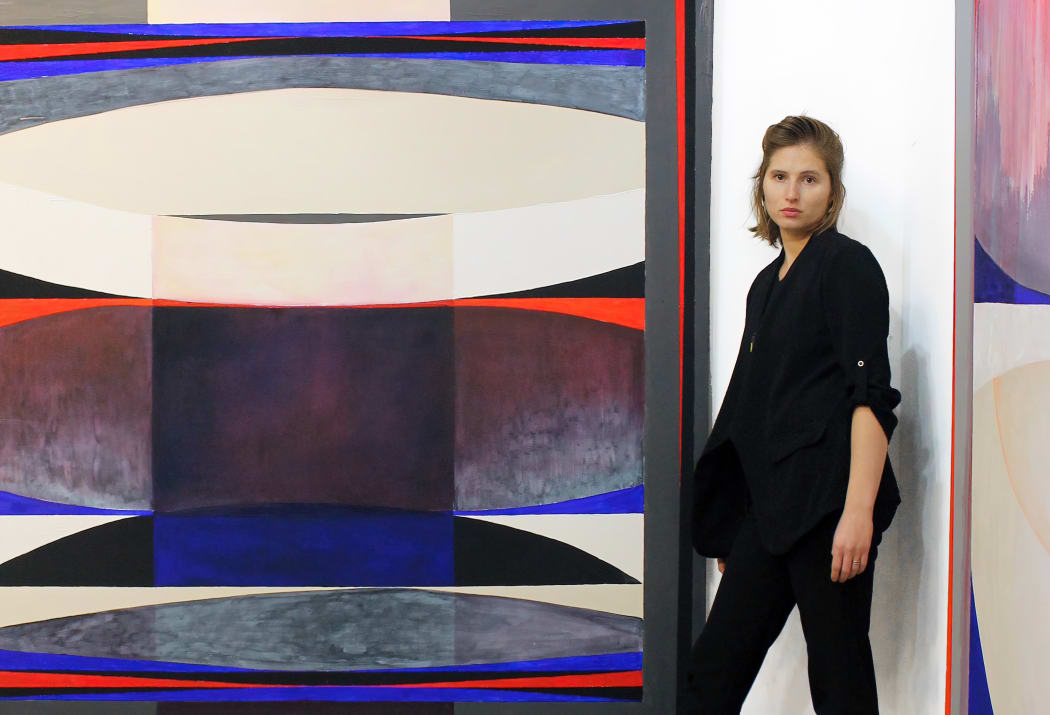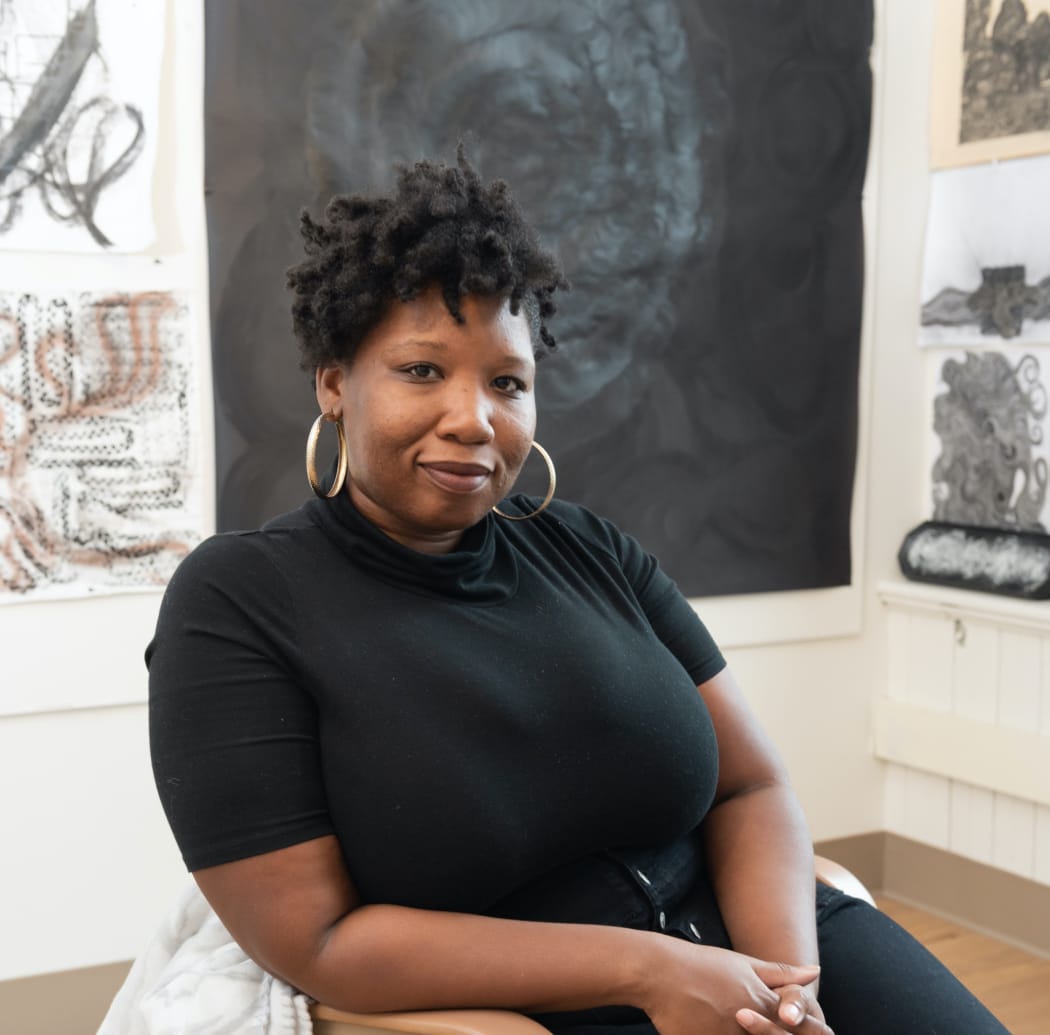-
 Sol LeWitt. Wavy Brushstrokes, 1995. Gouache on paper, 60 7/16 × 60 1/2 in (153.5 × 153.7 cm). Image courtesy of the Whitney Museum of Art, New York.
Sol LeWitt. Wavy Brushstrokes, 1995. Gouache on paper, 60 7/16 × 60 1/2 in (153.5 × 153.7 cm). Image courtesy of the Whitney Museum of Art, New York.The Art of Sol LeWitt
A Conversation with David S. ArefordA leading scholar on the work of Sol LeWitt, art historian David S. Areford has delved into the artist's extensive body of work through two recent books.
-
 Robert Rauschenberg working with master printer Robert Blackburn at ULAE (Universal Limited Art Editions), West Islip, NY, United States, 1962. Photo: Hans Namuth © Hans Namuth Estate / Courtesy of The Robert Rauschenberg Foundation Archives, New York.
Robert Rauschenberg working with master printer Robert Blackburn at ULAE (Universal Limited Art Editions), West Islip, NY, United States, 1962. Photo: Hans Namuth © Hans Namuth Estate / Courtesy of The Robert Rauschenberg Foundation Archives, New York.In Conversation with Larissa Goldston
Universal Limited Art Editions (ULAE)Universal Limited Art Editions (ULAE) played a pioneering role of the greatest significance in the development of printmaking in the United States.
-
 Adebunmi Gbadebo in her studio, New York, 2021. Courtesy of the artist
Adebunmi Gbadebo in her studio, New York, 2021. Courtesy of the artistStemming from a rejection of traditional materials as a result of their association with whiteness, Adebunmi Gbadebo uses hair from members of the African diaspora in her work, which encompasses sculptures, prints, paper, and paintings. Gbadebo views hair as intrinsically connected to history and culture in that it contains DNA, and is thus redolent of her own ancestry and lineage as well as other genealogies of the diaspora. Gbadebo is thus able to center Black people and histories as central aspects of the narrative through the medium in and of itself. The artist also used indigo dye and rice paper in addition to human hair in the series A Dilemma of Inheritance, a series inspired by her ancestors’ enslavement on two plantations in South Carolina. As some of this land now comprises a luxury golf course, Gbadebo has brought to light a narrative erased by history. All of her works can be viewed as conceptual archives steeped in history and memory. Gbadebo received her BFA from the School of Visual Arts in New York. Her work is currently included in the permanent collections of the Smithsonian National Museum of African Art, the Minneapolis Institute of Art, and the Minnesota Museum of American Art. She has also been included in solo and group exhibitions worldwide.
-
 Alteronce Gumby in his studio in the Bronx, New York, 2021. Courtesy of the artist
Alteronce Gumby in his studio in the Bronx, New York, 2021. Courtesy of the artistWhile part of a lineage of artists whose work is deeply invested in exploring color, Alteronce Gumby is interested in examining and redefining its stereotypical associations, which historically have resulted in division and oppression. Through the use of both iridescent pigments and his unique method of sliding glass over a wood panel, Gumby works against this precedent. The two combined result in transparency as well as reflection, causing the viewer to see themselves in the painting while also lose themselves through looking at the painting. As a result, his paintings give place to a bodily encounter. Through this interaction, Gumby seeks to engage the viewer in a visceral fashion in order to bring to light the myriad of ways in which color is related to both race and identity as well as the universality of color. Though abstract, Gumby titles his paintings in order to bring certain relationships to mind. Gumby studied at Hunter College before obtaining his MFA at Yale University. Gumby has held residencies at the Fondation des Etats-Unis, London Summer Intensive, Dumfries House Residency, and Summer Academy in Salzburg Austria, and has been included in numerous solo and group exhibitions worldwide.
In this conversation between Jennifer Earthman and Alteronce Gumby, Gumby describes abstraction’s ability to open up multiple possibilities as well as to result in a pause and a safe space, ever more important in our media-saturated world. He also discusses the broad significance of his materials in addition to race’s impact on his engagement with color: “Color and race are intertwined, and I want to use abstract painting to emancipate all perceptions of color and liberate all aspects of race.”
-
 Nelo Vinuesa at work in his studio. Benifayó, Valencia, Spain, 2021. Courtesy of the artist
Nelo Vinuesa at work in his studio. Benifayó, Valencia, Spain, 2021. Courtesy of the artistNelo Vinuesa’s vibrant abstractions stem from the artist’s deep connection to both color and the natural landscape. Vinuesa believes color is culturally and anthropologically resonant; as a result, the artist mixes his own colors in order to create hues that represent a certain psychological state or emotion stemming from his own life experience. Vinuesa is also deeply inspired by the landscape, viewing it as revelatory of our own existence, describing it as both inspiration and expression with regard to his painting. His work carries on Abstract Expressionism’s action painting legacy as he works quickly and intuitively in such a way that one can imagine the artist’s movements. Though he focuses on painting, the artist has also worked in audiovisual and video mediums, and cites them as important influences in his work. His paintings are personal yet strive to resonate to all through the expression of essential, universal emotions. Vinuesa studied fine art at the Polytechnic University of Valencia in Spain, and has been included in solo and group exhibitions worldwide. He has also been awarded grants and residencies in both London and Madrid.
In this conversation with art historian Jennifer Earthman, the artist discusses what draws him to abstraction, his creative process, and his artistic goals. His inspiration from nature alongside his interest in technological advances results in unique paintings emblematic of both primal and contemporary imagery. Related to his interest in universally communicative work is his belief in the need of spiritual transcendence in our contemporary world: “After overcoming the conflicts that marked the 20th century, we are still plunged into a kind of chaos … a reconnection with the spiritual can certainly serve us in the present, and this is precisely what draws me to abstraction.”
-
 Julia Rooney in her studio at the Brooklyn Army Terminal, New York, 2021. Courtesy of the artist
Julia Rooney in her studio at the Brooklyn Army Terminal, New York, 2021. Courtesy of the artistWhile based in painting, Julia Rooney’s work is interdisciplinary. The artist is interested in the use of nontraditional materials, such as dish-ware, newspaper, maps, and letters. She embeds these materials into her art in order to create complex, culturally significant multi-layered works. Rooney is also interested in exploring the ways in which painting can extend into three-dimensional space, prompting interactions with viewers. As Rooney states “The resulting paintings and sculptural forms I produce become palimpsests: fundamentally layered constructions of incompatible materials with diverse histories.” Her most recent work is invested in the pandemic’s impact: the artist has exclusively been creating six by six feet and two by two inch paintings in light of social-distancing measures and increased reliance on cell phones for communication and connection. Both of these scales result in the viewers’ heightened awareness of their own bodies. Rooney purposely used weak stretchers in order to fracture the larger paintings and mass-produced frames for the smaller paintings, resulting in cracks and imperfections that allude to the recently revealed weaknesses of our own socio-political and economic system. A visual artist and arts educator, Rooney obtained her Master’s in Fine Arts from Yale University. Rooney has held residencies as both an artist and arts educator, and has been included in numerous group and solo exhibitions.
In this conversation with Jennifer Earthman, the artist describes the path that led her to abstraction, abstraction’s pervasive history, and its particular relevance today: “In today’s world where the fact/fiction dichotomy is especially fraught, abstraction offers a third option—a way of thinking that does not foreclose thought, at the same time that it does not evade the messiness of debate.” She also discusses her belief in the psychological resonance of color, particularly through certain juxtapositions.
-
 Ashanté Kindle in her studio, 2021. Courtesy of the artist
Ashanté Kindle in her studio, 2021. Courtesy of the artistAshanté Kindle views her practice as a form of personal healing as she focuses on celebrating the history and beauty of Blackness using abstraction. Kindle utilizes abstracted s-curl or wave forms that resemble both the natural texture of Black hair as well as cartography in her monumental canvases. Kindle is interested in these marks as a result of an interest in the grid and the notion of mapping hair when styling it in addition to the idea of mapping out alternative safe universes for Black people, as in music videos from the nineties. Repetition is an integral part of her process through its meaning in relation to her body, emotions, and occupancy of space as well as resulting in a record of the labor of Blackness. Kindle views these repeated marks as representing the echo of a soft whisper or hysterical scream of emotion. The artist obtained her BFA from Austin Peay State University and is currently an MFA candidate at the University of Connecticut.
"Each single mark I make holds a single action and thought but together they represent time and hold the toll that the labor to create has taken on my body. I want the viewer to see the visual representation of my personal history as well as a single interpretation of the beauty that comes from the labor of Blackness," the artists declares in this conversation with Jennifer Earthman. Ashanté Kindle describes her personal relationship with abstraction as a way in which to reflect on her identity as a Black woman. She also discusses the notion of abstraction as an inclusive place as well as a communicative tool.
-
 Bryson Rand. Zack in Dappled Light (Fire Island), 2019. Archival inkjet print 40 × 28 in. 101.6 × 71.1 cm. Courtesy of the artist and Zeit Contemporary Art, New York
Bryson Rand. Zack in Dappled Light (Fire Island), 2019. Archival inkjet print 40 × 28 in. 101.6 × 71.1 cm. Courtesy of the artist and Zeit Contemporary Art, New YorkRon Gregg, Senior Lecturer in Film at Columbia University, sat down with Bryson Rand to talk about the most recent developments in Rand’s photographic practice.
-

